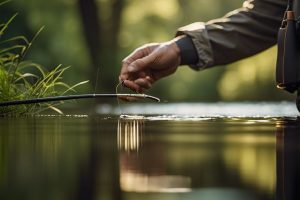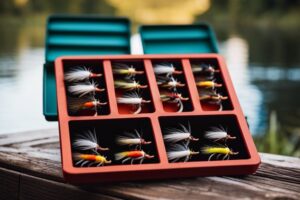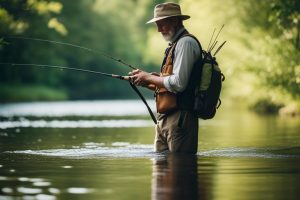With fly fishing being influenced by the changing seasons, it’s crucial for you to understand how the fishing experience varies throughout the year. By adjusting your approach to match the conditions of each season, you can significantly improve your chances of success. In this guide, you’ll learn about the best times to fish during different seasons and the recommended fly patterns to use, helping you make the most out of your fly fishing adventures throughout the year. Let’s dive in!
Key Takeaways:
- Spring: Spring is a common time for aquatic insect hatches, resulting in great dry-fly fishing opportunities.
- Summer: Early mornings and evenings are ideal for fishing in the summer to avoid the heat, and terrestrials like grasshoppers and ants can be effective fly patterns.
- Fall: Fall offers some of the best fishing as fish feed voraciously to store energy for the upcoming winter. Streamers and nymph patterns work well during this season.
- Winter: Winter fly fishing can be challenging but rewarding. Midges and small nymphs are effective patterns to use due to the limited insect activity in cold water.
- Best times to fish: Early mornings and evenings are typically the best times to fish during all seasons, as fish are more active during cooler temperatures.
- Seasonal fly patterns: Matching the hatch is crucial in fly fishing, so having a variety of patterns for different seasons is crucial. Be prepared with a selection of dry flies, nymphs, and streamers specific to each time of year.
- Consider water temperatures: Water temperature plays a significant role in fish activity. Understanding how temperatures change by season can help determine the best times to fish and what patterns to use.
Spring Fly Fishing
The arrival of spring brings new life to the water and fresh opportunities for fly fishing. The warming temperatures trigger insect activity and fish become more active, making it an excellent time to get out on the water.
Best Times to Fish in Spring
With the snow melting and streams running higher, early spring can offer some challenging conditions, but as the water levels stabilize, the fishing can improve. Warmer days are ideal for fishing as fish are more likely to be active, typically in the afternoon. Keep an eye on water temperatures as they start to rise, indicating that fish will become more active and feeding greater.
Seasonal Fly Patterns for Spring
Patterns that mimic emerging insects such as caddisflies, mayflies, and stoneflies are popular choices in spring. Consider using nymphs, dry flies, and wet flies to match the different stages of insect activity. In the spring, fish are often keying in on the insects near the water’s surface, so fishing with dry flies can be very effective.
Times when hatches are occurring can provide incredible fly fishing opportunities. As the bugs start to hatch, try matching the hatch with the appropriate fly pattern to entice the fish to bite. Look for rising fish and cast your flies just ahead of where you see them feeding to increase your chances of hooking into a fish.
Summer Fly Fishing
Warm Weather Strategies
One of the best times for fly fishing in the summer is early mornings and evenings when the temperatures are cooler. During the middle of the day, fish tend to move to deeper waters or seek out shaded areas, making it more challenging to catch them. As the sun rises higher in the sky, consider focusing your efforts on shaded spots, slower moving waters, or areas with aquatic vegetation where fish may seek refuge from the heat.
Summer Fly Patterns and Hatches
Any successful summer fly fishing outing requires matching your flies to the insects that are most active during that time. In summer, you can expect to encounter hatches of mayflies, caddisflies, and stoneflies. Some popular fly patterns for summer include Elk Hair Caddis, Pale Morning Duns, and Grasshoppers. These flies mimic the insects that are prevalent during the warmer months, increasing your chances of enticing a strike from fish.
Understanding the local hatches and selecting the right fly patterns can significantly improve your summer fly fishing success. Keep an eye out for rising fish and listen for their feeding activity to help you identify which flies to use. Being observant of the water conditions and the insects present will help you make informed decisions about your fly selection, leading to a more fruitful fishing experience.
Autumn Fly Fishing
Transitioning to Cooler Waters
To enhance your autumn fly fishing experience, it’s vital to understand the seasonal transitions in water temperature and trout behavior. Refer to Fly Fishing Season Transitions- Strategies for Trout for valuable insights. An abrupt change in weather can trigger fish to move to deeper, cooler waters. As autumn progresses, focus on fishing in the early mornings or late evenings when the water is cooler and fish are more active.
Fall Fly Patterns and Migration
Fishing with suitable fall fly patterns can significantly increase your chances of success. Fall fly patterns often mimic natural insects that are prevalent during this season, such as mayflies, caddisflies, and midges. Migration patterns of trout also shift during autumn, as they move closer to spawning grounds. To capitalize on this behavior, target areas with gravel beds or tributaries where trout typically congregate during the fall months.
Winter Fly Fishing
Cold Weather Tactics
Keep in mind that winter fly fishing can be challenging due to colder water temperatures, decreased insect activity, and limited hatches. However, this doesn’t mean you can’t catch fish during the winter months. In fact, trout are still actively feeding, just at a slower pace.
Winter Fly Patterns and Nymphing
Fishing with smaller nymphs and midges can be highly effective during the winter months. When selecting winter fly patterns, opt for sizes ranging from 18 to 22 to match the smaller insects that trout feed on in colder water. Additionally, consider using weighted flies or adding split shot to your leader to get your flies down to the fish in deeper, slower-moving water.
Plus, don’t neglect the importance of presentation. Make sure your drifts are drag-free and precise, as trout in cold water are less likely to chase down a subpar offering. Be patient and keep adjusting your approach until you find success.
Seasonal Fly Selection
Many fly fishers find that adjusting their fly selection based on the season can greatly improve their chances of success on the water. Matching your fly patterns to the natural insects and baitfish that are prevalent during each season can make a significant difference in your fishing results.
Dry Flies for Each Season
An necessary part of fly fishing is knowing which dry flies to use during each season. In the spring, consider using mayfly and caddis patterns as insects begin to hatch. During the summer months, terrestrial patterns like grasshoppers and ants can be effective as they fall into the water. In the fall, switching to larger attractor patterns like stimulators and hopper imitations can entice trout that are feeding aggressively before winter sets in.
Nymphs and Streamers for Each Season
One effective strategy for fly fishing in all seasons is to have a selection of nymphs and streamers in your fly box. Nymph fishing can be productive year-round, with patterns like Pheasant Tails and Hare’s Ears working well in the spring and summer. As the temperatures drop in the fall and winter, switching to streamers like Wooly Buggers and Zonkers can be a great way to target larger fish that may be feeding on baitfish.
Seasonal variations in fly fishing provide a dynamic and engaging experience for anglers throughout the year. By understanding the best times to fish and selecting the appropriate fly patterns for each season, you can enhance your chances of success on the water. So, be prepared to adjust your approach as the seasons change and enjoy the thrill of hooking into that next big catch.
Adapting to Seasonal Changes
Your success in fly fishing greatly depends on your ability to adapt to the changes in each season. Understanding how the different seasons affect fish behavior, water conditions, and insect activity is crucial. For example, in the spring, fish tend to be more active as they feed heavily after the winter months. This is a great time to use nymphs and streamers to mimic the insects and baitfish that the fish are feeding on. As the weather warms up in the summer, fish may become more selective in their feeding, requiring more precise presentations with dry flies or emergers.
In terms of fly patterns, it’s important to match the hatch during each season. In the spring, look for patterns that mimic emerging aquatic insects such as mayflies and caddisflies. In the summer, focus on terrestrials like grasshoppers and ants that fall into the water. In the fall, streamers that imitate baitfish can be highly effective as fish bulk up for the winter. Recall, the best times to fish can vary depending on the season, so be sure to check local fishing reports and consult with seasoned anglers for the most up-to-date information.
Reading Water and Adjusting Tactics
The key to successful fly fishing is being able to read the water and adapt your tactics accordingly. By understanding how fish relate to different types of water structures such as riffles, pools, and runs, you can strategically target your casts to increase your chances of success. In the spring, fish often seek shelter in slower-moving water near the banks, while in the summer, they may move to deeper pools to escape the heat. Adjusting your presentation and fly selection based on these factors can make a significant difference in your catch rate.
Staying Flexible and Observant
The ability to stay flexible and observant on the water is crucial in fly fishing. Pay attention to the behavior of the fish, the insects hatching, and any changes in weather conditions. Being able to quickly adapt your technique and fly choice based on these observations can greatly increase your chances of hooking into fish. Plus, don’t be afraid to experiment with different flies and techniques to see what works best on any given day. Recall, each day on the water is a learning experience, and the more adaptable you are, the more successful you will be in catching fish.
To wrap up
Taking this into account, it is crucial to understand how fly fishing varies by season in order to make the most of your fishing trips. By paying attention to the different behaviors of fish during each season, you can adjust your fishing techniques and gear accordingly. Remember that spring and fall are generally considered the best times for fly fishing, as water temperatures are ideal and insects are abundant.
Additionally, knowing the seasonal fly patterns can greatly improve your chances of success. By matching your fly selection to the insects that are most prevalent during each season, you can increase your chances of hooking a big one. Keep in mind that experimentation is key – don’t be afraid to try different flies and techniques until you find what works best for you in each season. Happy fishing!
Seasonal Fly Fishing – What You Need to Know
Q: What are the different seasons for fly fishing?
A: Fly fishing can be enjoyed year-round, but the primary seasons are spring, summer, fall, and winter, each offering unique conditions and challenges.
Q: When is the best time to go fly fishing in spring?
A: Spring is a great time for fly fishing as fish become more active after the winter months. The best times to fish are usually early morning or late afternoon.
Q: What are some popular fly patterns for spring fly fishing?
A: Popular spring fly patterns include nymphs, wet flies, and streamers such as March Browns, Blue Winged Olives, and Woolly Buggers.
Q: When is the best time to go fly fishing in summer?
A: Summer can be hot, so early mornings or evenings are ideal for fly fishing. Fish tend to be more active during these cooler times of the day.
Q: What are some popular fly patterns for summer fly fishing?
A: Effective summer fly patterns include dry flies like Elk Hair Caddis, Stimulators, and Pale Morning Duns, as well as terrestrials like ants and beetles.
Q: When is the best time to go fly fishing in fall?
A: Fall is a popular season for fly fishing as fish feed voraciously before winter. The best times to fish are typically during overcast days or when there is a light drizzle.
Q: What are some popular fly patterns for fall fly fishing?
A: Recommended fall fly patterns include streamers like Woolly Buggers and Zonkers, as well as nymphs like Hare’s Ear and Pheasant Tail nymphs.
Q: When is the best time to go fly fishing in winter?
A: Winter fly fishing can be challenging but rewarding. The middle of the day, when temperatures are relatively warmer, is usually the best time to fish in winter.
Q: What are some popular fly patterns for winter fly fishing?
A: Effective winter fly patterns include midges, small nymphs like Zebra Midges, and streamers like Woolly Buggers in dark colors to imitate small baitfish.


